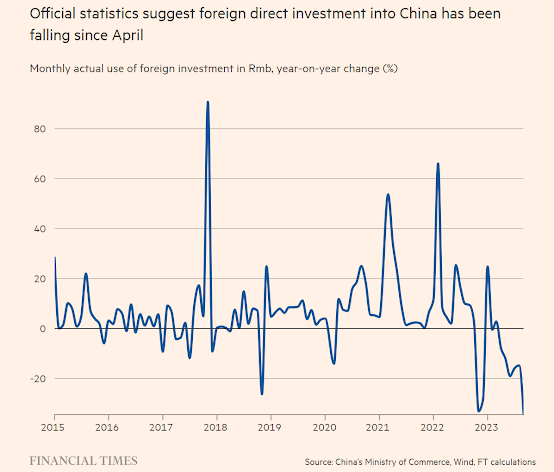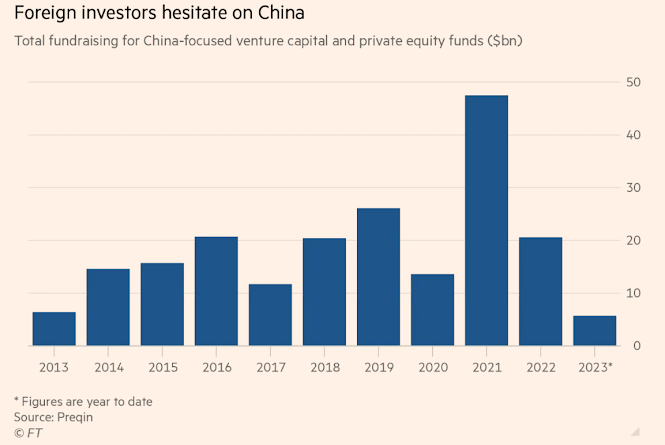Plunging foreign direct investment piles pressure on China’s economy
Financial Times analysis shows FDI tumbled 34% in September after recording double-digit falls every month since May
Thomas Hale in Shanghai, Ryan McMorrow in San Francisco and Andy Lin in Hong Kong
 Analysts said the data suggested that foreign companies were moving capital out of China © FT montage/Dreamstime
Analysts said the data suggested that foreign companies were moving capital out of China © FT montage/DreamstimeForeign direct investment into China is falling across multiple measures, adding to pressure on Beijing and local governments as they seek to counter an economic slowdown.
Financial Times calculations based on Chinese commerce ministry data compiled by Wind show that FDI fell 34 per cent to Rmb72.8bn ($10bn) year on year in September, the biggest decline since monthly figures became available in 2014.
The weakness in FDI has been part of a steady march of disappointing economic readings since China lifted pandemic restrictions at the start of the year.
While FDI leapt 15 per cent in January on the previous year, it has recorded double-digit percentage declines every month since May.
In renminbi terms, year-to-date inflows under China’s commerce ministry data remain just 8 per cent short of last year’s record pace.
But the country’s balance of payments data also reveals a deteriorating picture of foreign investment.
Direct investment liabilities, a gauge of foreign capital flowing into the country, were $6.7bn in the second quarter, based on a September readjustment of earlier figures, the lowest of any quarter since 2000 and down from $21bn in the first three months of the year.
Recent falls contrast with the boom in foreign investment that China enjoyed during the pandemic even as the country was almost sealed off to the outside world.
FDI reached an annual record of $189bn in 2022, according to commerce ministry data.
The most recent commerce ministry data of FDI is only available in renminbi, after the government stopped releasing dollar-denominated monthly FDI figures in August.
It also stopped publishing youth unemployment figures in July.
Brad Setser, a senior fellow at the Council on Foreign Relations, said the data suggested that “foreign companies are no longer reinvesting back in China”.
Instead, he added, “they are getting [their] profits out of the country as fast as they can”.
Local governments, under pressure from a property crisis and the legacy of shouldering the costs of zero-Covid policies, have courted foreign executives as they return to China for the first time in years.
But visiting business delegations have kept a low profile against a backdrop of worsening diplomatic relations with the US and western calls to “de-risk” supply chains.
Chinese regions that historically benefited from foreign investment are now instead being forced to seek alternative financing.
One manufacturer in eastern Jiangsu province said companies were relying on government funding to replace overseas investors.
Larry Hu, chief China economist at Macquarie, suggested that a major driver of the FDI decline was higher interest rates in the US.
This incentivised US companies to “reshore” working capital from China, he said.
Ten-year Treasury rates this week hit 5 per cent for the first time since 2007, while Beijing has trimmed core lending rates in recent months.
“US yields continue to go higher and China yields [are] flat-ish,” Hu added.
“That creates a very large arbitrage opportunity.”
In a report this week, Goldman Sachs analysts pointed to concerns about “capital flight” while noting “conflicting signals”.
Commerce ministry data suggested that declining FDI inflows were mainly due to “outflow of reinvested earnings”, they wrote.
They noted that the focus of FDI was also rotating, as financing shifted from manufacturing to sectors including finance, IT and scientific research, reflecting potential “supply chain diversification”.
They added that Hong Kong’s share of FDI had increased compared with other major financial centres.
Logan Wright, head of China markets research at Rhodium Group, said the commerce data could be inflated by counting round-tripping, in which local enterprises send money to Hong Kong and then back to the mainland to benefit from incentives for foreign investors.
He added that while the commerce ministry FDI and balance of payments data sets were “indicative of a broader trend of weaker inflows” from foreign investors, he also pointed to an alternative transaction-based approach to measuring FDI.
Data from research provider Preqin, which tracks foreign funding raised by venture and private equity groups investing in China, shows that such funds have raised only $5.7bn this year, about a quarter of last year’s total and a fraction of the $48bn raised in 2021.
There are signs of growing concern within China about the FDI drought.
At a celebration of Beijing’s $1tn Belt and Road global infrastructure initiative last week, President Xi Jinping said Beijing would remove restrictions on foreign investment in its manufacturing sector.
“China can only do well when the world is doing well,” he said.
“When China does well, the world will get even better.”



0 comments:
Publicar un comentario